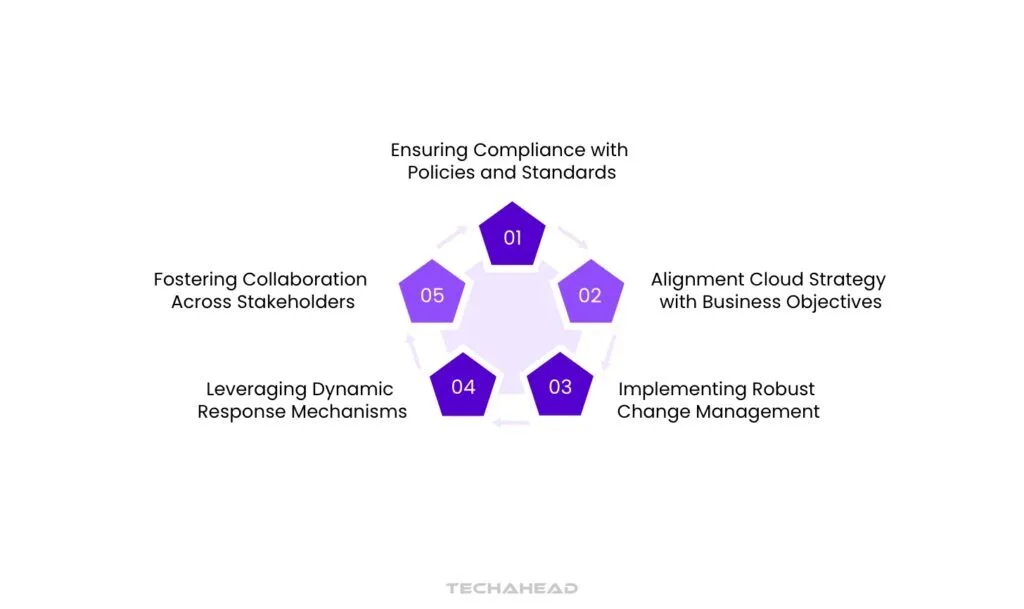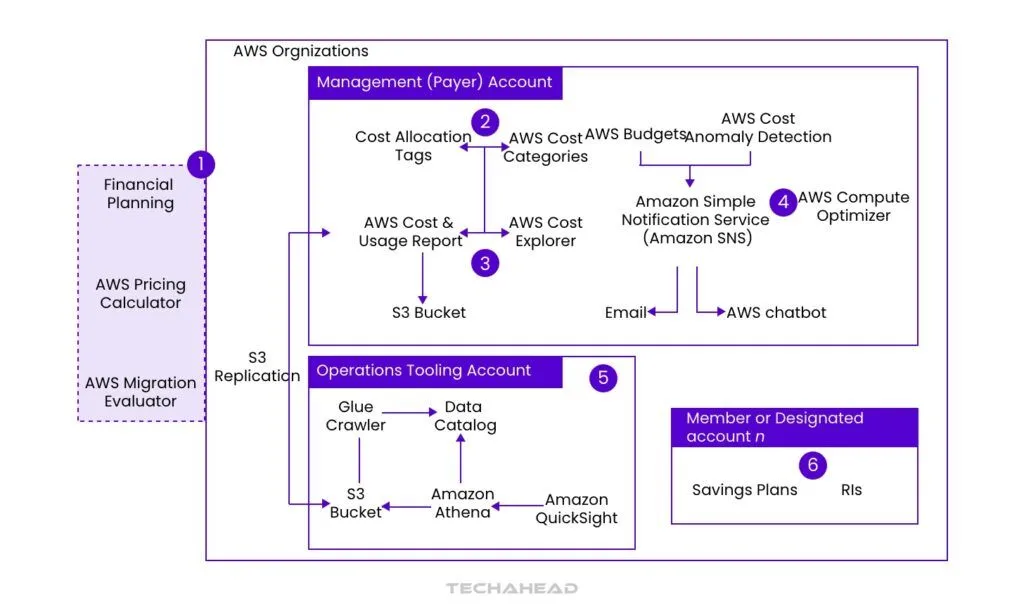 DA 70+ Guest Post Placements – Elite Authority at Your Fingertips!
DA 70+ Guest Post Placements – Elite Authority at Your Fingertips!
Cloud Governance Simplified: Strategies to Operational Efficiency
Written by TeachAhead » Updated on: December 09th, 2024


Cloud governance encompasses a set of policies and controls that streamline and regulate cloud usage for ongoing compliance. Given the dynamic nature of cloud environments and their interconnected components, an effective governance framework is essential. It prevents misconfigurations, mitigates security risks, and addresses operational inefficiencies.
The global cloud governance platform market is expected to surge to USD 3.87 billion by 2034, reflecting a strong CAGR of 12.5%. This growth, reported by Future Market Insights, stems from rising AI integration, hybrid cloud adoption, and stringent compliance demands. The market is projected to grow from USD 2.03 billion in 2024, driven by these transformative trends.
In 2022, the global multi-cloud management market was valued at USD 102.19 billion. It is projected to grow at a robust CAGR of 14.7% between 2023 and 2030.

An effective governance strategy offers clarity and control over critical aspects of cloud operations. It aligns all components, ensuring they collectively meet organizational goals. Additionally, it fosters scalability by standardizing processes that evolve with business demands.
This blog will explore all the aspects that come into cloud governance and outline best practices to enhance implementation and compliance.
What is Cloud Governance?
 Cloud governance refers to the framework of rules, policies, and best practices that organizations adopt to manage their cloud-based services. Its primary goal is to enforce data security, mitigate risks, and ensure the smooth operation of cloud infrastructure.
Cloud governance refers to the framework of rules, policies, and best practices that organizations adopt to manage their cloud-based services. Its primary goal is to enforce data security, mitigate risks, and ensure the smooth operation of cloud infrastructure.
The cloud revolutionizes the way organizations deploy systems and assets. It allows teams to innovate rapidly, enabling one-click deployment across multiple environments. While this boosts productivity, it also creates several challenges.
Integration Issues Across Cloud Systems
Despite using the same cloud platform, departments may struggle with poor integration. Cloud governance establishes seamless data flow and data interoperability, aligns systems, and enhances collaboration across departments.
Data Redundancy and Duplication
In large businesses, multiple teams might create similar assets or datasets. This results in unnecessary duplication and inefficiencies. Cloud governance ensures centralized data management, streamlining workflows and reducing redundancy.
Misalignment with Business Objectives
Cloud systems can grow rapidly, but if not aligned with business goals, they may become siloed. A strong cloud governance strategy ensures that cloud assets and services directly support the company’s core objectives, creating measurable value.
Security Vulnerabilities
With the increase in cloud migration, weak or inconsistent access control becomes a significant threat. Cloud governance enforces robust security protocols, ensuring that cloud systems meet industry standards for data protection and compliance.
Why is Cloud Governance Important?
 Cloud governance is crucial for organizations leveraging critical cloud services. Here’s how it drives efficiency and security across your cloud infrastructure.
Cloud governance is crucial for organizations leveraging critical cloud services. Here’s how it drives efficiency and security across your cloud infrastructure.
Enhances Cloud Resource Management
Cloud governance allows organizations to segment cloud systems by departments, projects, or cost centers. This approach ensures granular control over cloud resources, providing better cost tracking and improving visibility. Cloud-based governance helps isolate workloads, minimizing the risk of security breaches and optimizing resource allocation across the organization.
Minimizes Shadow IT Risks
Organizations face significant risks when they lack visibility into which cloud systems and data are deployed. Employees often resort to shadow IT, bypassing official IT protocols. Cloud-based governance provides a structured way for employees to request cloud resources, maintaining visibility, compliance, and control. It ensures that cloud assets are deployed within the organization’s security and budget constraints, preventing shadow IT practices.
Reduces Administrative Overhead
Managing cloud systems manually through spreadsheets or outdated tools is inefficient and error-prone. Without a proper cloud-based governance framework, organizations struggle to monitor cloud accounts, budgets, and compliance. A robust cloud governance solution centralizes policy enforcement, streamlining access controls, cost management, and compliance. This reduces administrative burdens, enhances operational efficiency, and minimizes the risk of non-compliant actions.
Strengthens Cloud Security
Effective cloud governance enforces a comprehensive authentication strategy to protect critical data and systems. It ensures robust security measures across cloud environments, regardless of where data is stored. With continuous monitoring, organizations can detect vulnerabilities, ensuring sensitive information remains protected and accessible only to authorized personnel. Governance that is cloud-based aligns security controls with compliance requirements, offering peace of mind.
Cloud Governance Model Principles
 A robust cloud governance model ensures structured and secure cloud management. Below are some key principles, thoroughly explained.
A robust cloud governance model ensures structured and secure cloud management. Below are some key principles, thoroughly explained.
Ensuring Compliance with Policies and Standards
Compliance is the backbone of any cloud governance framework. Organizations must adhere to industry-specific regulations like GDPR, HIPAA, or SOC 2, as well as their internal policies.
Cloud governance ensures these standards are woven into daily operations, from data storage to application deployment. Automated compliance checks within cloud environments can identify gaps, helping organizations avoid penalties or reputational damage. This principle also mandates regular audits and reporting to demonstrate adherence to standards.
Alignment Cloud Strategy with Business Objectives
For cloud initiatives to be effective, they must integrate seamlessly with an organization’s broader business strategy. A cloud-based governance framework ensures every cloud resource, policy, and deployment aligns with measurable business goals.
For example, if scalability is a business priority, governance ensures cloud policies support rapid resource provisioning during peak demand. This alignment not only optimizes resource allocation but also ensures that cloud investments contribute to key objectives like customer satisfaction, cost efficiency, and market competitiveness.
Fostering Collaboration Across Stakeholders
Cloud environments often involve multiple teams, including IT, finance, operations, and development. Without collaboration, cloud resources risk being misused or mismanaged.
Cloud governance fosters a culture of shared accountability, with clear roles and responsibilities for each stakeholder. For instance, IT may oversee security, while finance monitors cloud budgets. Governance frameworks often include service-level agreements (SLAs) that outline how resources are shared and managed across teams, ensuring equitable and efficient usage.
Implementing Robust Change Management
Cloud environments are highly dynamic, with frequent updates to software, configurations, or workloads. Change management ensures these updates occur in a controlled manner, reducing risks like downtime or compatibility issues. A cloud governance model establishes workflows for change approvals, impact assessments, and rollback plans.
For example, any update to a cloud database should undergo testing and approval before deployment. This principle not only protects cloud infrastructure but also ensures minimal disruption to business operations.
Leveraging Dynamic Response Mechanisms
Cloud environments are prone to unpredictable events, from sudden traffic surges to potential security breaches. Cloud governance leverages real-time monitoring tools and automation to address these challenges.
For instance, automated scaling policies can provision additional resources during high traffic, ensuring uninterrupted service. Similarly, automated threat detection systems can isolate vulnerabilities before they escalate. This principle emphasizes agility, enabling organizations to respond proactively to both opportunities and risks in their cloud environments.
How to Design and Implement a Cloud Governance Framework?
A well-structured cloud governance framework is crucial for maintaining control, security, and efficiency in cloud environments. Here are the primary components, expanded and enhanced for better understanding.
Cloud Financial Management

Managing cloud expenses effectively is key to leveraging its cost-saving potential. Poor oversight can result in spiraling costs. This component focuses on three critical elements:
Financial Policies
Establish clear policies for cloud usage to optimize expenditure. For instance, define when to use managed services to reduce operational overhead or mandate a cost management checklist before launching new cloud services. These policies ensure resources are deployed wisely, aligning with organizational financial goals.
Budget
Allocate precise budgets across departments, projects, or service categories. Budgets act as a boundary, preventing overspending while ensuring necessary resources are funded. For example, development teams may get a larger allocation for testing environments, while administrative tasks have smaller allowances.
Cost Reporting
Transparent cost reporting is essential for tracking expenses accurately. However, unpredictable charges like backup snapshots stored in various regions can complicate this process. Employ vendor-provided tools or advanced third-party solutions to consolidate multi-cloud cost reporting. This practice provides visibility into expenses and aids in proactive cost management.
Cloud Operations Management
 Effective operations management ensures seamless cloud service deployment and maintenance. This includes:
Effective operations management ensures seamless cloud service deployment and maintenance. This includes:
Resource Allocation
Define and monitor the resources required for services over time. Specify exact CPU, memory, and storage needs, preventing over-provisioning or underutilization.
Service-Level Agreements (SLAs)
Establish SLAs to set clear expectations for service performance, ensuring uptime, latency, and scalability meet business requirements.
Monitoring and Compliance
Continuous monitoring ensures SLAs are consistently met. Automated checks prevent deployment of non-compliant code or unauthorized configurations.
Access Control and Authorization
Restrict cloud access to authorized personnel. For example, developers may have access to testing environments but not production systems, ensuring secure operations.
By governing cloud operations tightly, businesses can avoid shadow IT, optimize resource utilization, and achieve higher returns on investment.
Cloud Data Management
 The massive volume of data in the cloud requires structured management throughout its lifecycle. Key strategies include.
The massive volume of data in the cloud requires structured management throughout its lifecycle. Key strategies include.
Data Classification Policies
Develop a classification scheme to label data based on sensitivity. For instance, financial records may be labeled as “confidential,” while analytics data is tagged as “general use.” Policies should dictate access and usage levels accordingly.
Encryption Standard
Ensure data is encrypted both at rest and during transmission to protect against unauthorized access or breaches.
Access Control and Masking
Implement robust access controls for sensitive data. For example, use data masking to obscure personal identifiers during development or testing.
Data Tiering Strategies
Optimize storage costs by transitioning older or less frequently used data from high-cost systems to archival solutions over time.
Automated Lifecycle Management
Automate data lifecycle policies to ensure compliance and efficiency in large-scale deployments. Automated workflows can transition data or apply deletion policies when needed.
Cloud Security and Compliance Management
 This component ensures cloud security practices align with organizational needs and regulatory mandates. A comprehensive cloud governance framework addresses this.
This component ensures cloud security practices align with organizational needs and regulatory mandates. A comprehensive cloud governance framework addresses this.
Risk Assessment
Identify potential vulnerabilities in the cloud environment. Prioritize risks based on their impact and likelihood, then mitigate them proactively.
Identity and Access Management (IAM)
Enforce IAM strategies, such as multi-factor authentication, to prevent unauthorized access. IAM policies should ensure employees only access resources relevant to their roles.
Application Security
Establish protocols for secure application deployment. Regularly update software to address vulnerabilities and employ secure coding practices.
Disaster Recovery
Define disaster recovery plans to ensure minimal disruption during outages. Regularly test these plans to verify their effectiveness.
By balancing security requirements with business priorities, this component ensures compliance while enabling agility in cloud operations.
Conclusion
Cloud governance takes a policy-driven approach to managing and operating cloud environments. It establishes consistent controls and processes for handling identities, access management, security protocols, and compliance safeguards. This approach helps prevent users from unintentionally implementing unauthorized configurations within cloud services.
While you may already perform some of these tasks, cloud governance integrates them into a unified strategy, significantly reducing the likelihood of errors. Governance solutions provide continuous monitoring of your cloud environments and can automatically block policy breaches in real time, minimizing the risk of costly mistakes.
One of the most reliable methods to protect your environment from unintended changes is by ensuring all infrastructure updates are implemented through an automated Infrastructure as Code (IaC) process.
Source URL: https://www.techaheadcorp.com/blog/cloud-governance-simplified-strategies-to-operational-efficiency/
Note: IndiBlogHub features both user-submitted and editorial content. We do not verify third-party contributions. Read our Disclaimer and Privacy Policyfor details.
Copyright © 2019-2025 IndiBlogHub.com. All rights reserved. Hosted on DigitalOcean for fast, reliable performance.














